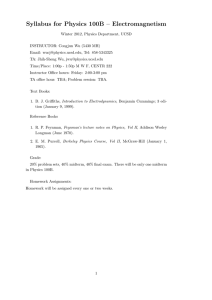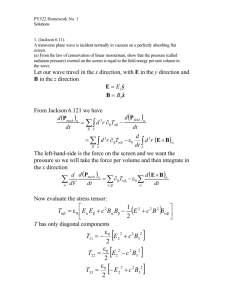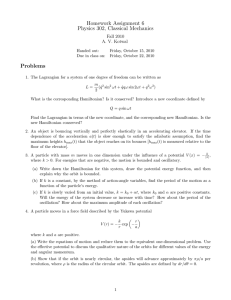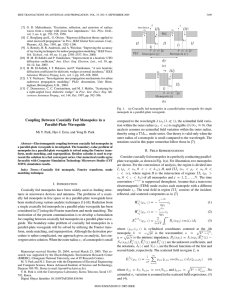Journal of Physics Special Topics
advertisement
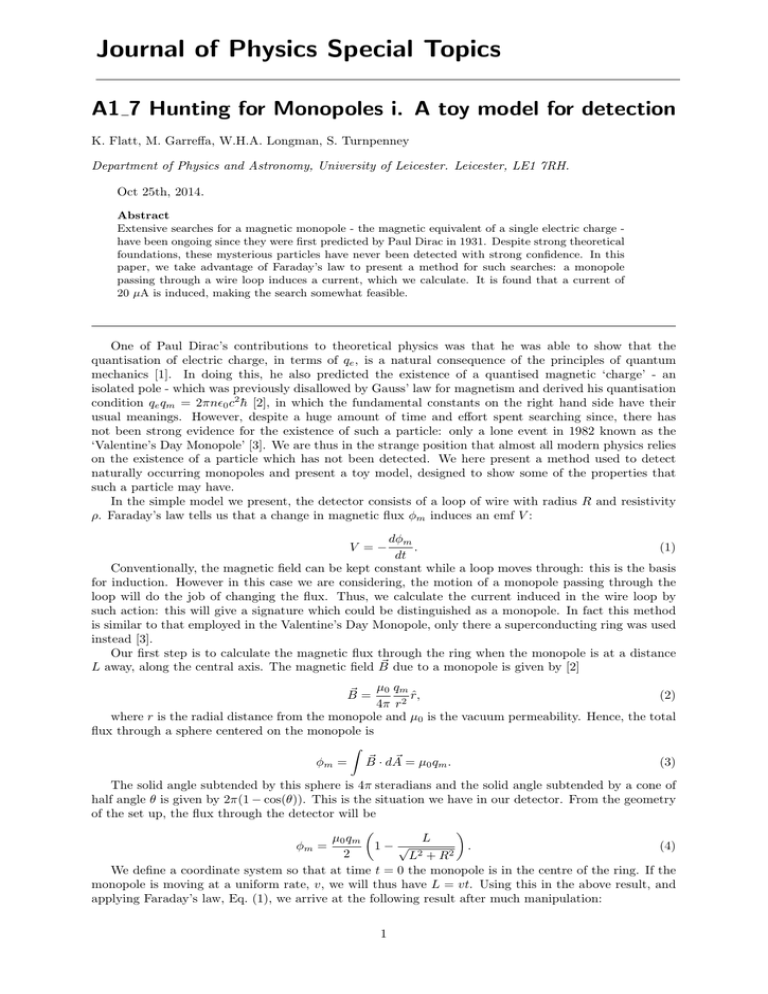
Journal of Physics Special Topics A1 7 Hunting for Monopoles i. A toy model for detection K. Flatt, M. Garreffa, W.H.A. Longman, S. Turnpenney Department of Physics and Astronomy, University of Leicester. Leicester, LE1 7RH. Oct 25th, 2014. Abstract Extensive searches for a magnetic monopole - the magnetic equivalent of a single electric charge have been ongoing since they were first predicted by Paul Dirac in 1931. Despite strong theoretical foundations, these mysterious particles have never been detected with strong confidence. In this paper, we take advantage of Faraday’s law to present a method for such searches: a monopole passing through a wire loop induces a current, which we calculate. It is found that a current of 20 µA is induced, making the search somewhat feasible. One of Paul Dirac’s contributions to theoretical physics was that he was able to show that the quantisation of electric charge, in terms of qe , is a natural consequence of the principles of quantum mechanics [1]. In doing this, he also predicted the existence of a quantised magnetic ‘charge’ - an isolated pole - which was previously disallowed by Gauss’ law for magnetism and derived his quantisation condition qe qm = 2πn0 c2 h̄ [2], in which the fundamental constants on the right hand side have their usual meanings. However, despite a huge amount of time and effort spent searching since, there has not been strong evidence for the existence of such a particle: only a lone event in 1982 known as the ‘Valentine’s Day Monopole’ [3]. We are thus in the strange position that almost all modern physics relies on the existence of a particle which has not been detected. We here present a method used to detect naturally occurring monopoles and present a toy model, designed to show some of the properties that such a particle may have. In the simple model we present, the detector consists of a loop of wire with radius R and resistivity ρ. Faraday’s law tells us that a change in magnetic flux φm induces an emf V : dφm . (1) dt Conventionally, the magnetic field can be kept constant while a loop moves through: this is the basis for induction. However in this case we are considering, the motion of a monopole passing through the loop will do the job of changing the flux. Thus, we calculate the current induced in the wire loop by such action: this will give a signature which could be distinguished as a monopole. In fact this method is similar to that employed in the Valentine’s Day Monopole, only there a superconducting ring was used instead [3]. Our first step is to calculate the magnetic flux through the ring when the monopole is at a distance ~ due to a monopole is given by [2] L away, along the central axis. The magnetic field B V =− ~ = µ0 qm r̂, B (2) 4π r2 where r is the radial distance from the monopole and µ0 is the vacuum permeability. Hence, the total flux through a sphere centered on the monopole is Z ~ · dA ~ = µ0 qm . φm = B (3) The solid angle subtended by this sphere is 4π steradians and the solid angle subtended by a cone of half angle θ is given by 2π(1 − cos(θ)). This is the situation we have in our detector. From the geometry of the set up, the flux through the detector will be L µ0 qm 1− √ . (4) φm = 2 L2 + R2 We define a coordinate system so that at time t = 0 the monopole is in the centre of the ring. If the monopole is moving at a uniform rate, v, we will thus have L = vt. Using this in the above result, and applying Faraday’s law, Eq. (1), we arrive at the following result after much manipulation: 1 Hunting for Monopoles i. A toy model for detection, Oct 25th, 2014. µ0 qm v V = 2 R v 2 t2 1+ 2 R −3/2 . (5) There are two things to note based on this result. Firstly, due to the t2 dependence the induced emf is symmetric with respect to the position of the monopole: the induced current will hence be equal and in the same direction when the particle is at positive or negative L. This is opposite to the case of a bar magnet passing through the ring: the current induced when t > 0 will tend to oppose that induced when t < 0. In the case of the superconducting ring, the final current would be zero for a bar magnet; here, a standing current would be set up which would stay indefinitely in the loop. Secondly, it should be noted that a key assumption of this derivation is that the monopole stays at constant velocity for all time. Clearly, work must be done to induce a current and in reality this will come from the kinetic energy of the monopole. A possibility for future investigation is to look at the effect of relaxing this approximation. In our proposed experiment, the detector is non-superconducting and so we may use Ohm’s law to find the current at a given time. The total resistance of the wire will be given by 2πρR/A, where A is the cross sectional area of the wire. It can be seen from Eq. (5) that the emf and hence current will peak at t = 0 and at this time the current I0 will be I0 = hA v , 4πρe R2 (6) where e is the fundamental charge and we have used the Dirac quantisation condition (with n = 1) to further simplify the expression. It is interesting to note that the current induced is inversely proportional to the square of the radius: thus a larger detector will have a weaker signal. However if we make the detector larger we have a greater chance of a monopole passing through it - and as it is an area this probability will increase with R2 . Hence, the two proportionalities will exactly cancel and therere is a pay off between the two factors - a smaller ring will be able to detect monopoles with a stronger signal but may miss possible events. One way around this would be to have a grid of wire ring detectors spread over a large area. In order to estimate the current induced, we need numerical values for the four parameters ρ, A, v and R. If the detector is constructed from 12 gauge, copper wire it will have a resisitivity of ρ = 1.7×10−8 Ωm and a cross sectional area of 3.31×10−6 m2 [4]. The speed of the monopole can be taken as approximately c, the speed of light. Whilst this will not be true, we are looking at a limiting case and so it is acceptable to consider relativistic motion. The radius can be arbitrarily chosen and so for simplicity we choose 1 m. Using these values in Eq. (6), we find a peak current of I0 = 19.3 µA, a current which should easily be detectable by an ammeter. In this report, we have analysed a toy model for detecting magnetic monopoles which consists of a simple copper wire and calculated a signature current which would be induced in the wire when a monopole passes through. One problem with this method would be that the width of the curve, Eq. (5) would be characterised by a time constant τ = R/v and, for relativistic monopoles, this would be much smaller than the resolution of ammeters. A way to get around this problem would be to implement a way of slowing the monopoles down as they approach the detector, and in a later article in this journal we look at the possibility of doing this [5]. We also note that an implicit assumption in the calculation we have made is that the monopole travels axially through the detector: in reality this would not be the case and further work may be to generalise the result for such cases. References [1] G. Farmelo, The Strangest Man: The Life of Paul Dirac, Quantum Genius, Faber and Faber, London, 2010 [2] A. Rajante, Introduction to Magnetic Monopoles, Contemporary Physics, Vol. 53, Iss. 3, 2012 [3] B. Cabrera, First Results from a Superconductive Detector for Moving Magnetic Monopoles, Physical Review Letters, Vol. 48, 1982 [4] P.A. Tipler and G. Mosca, Physics for Scientists and Engineers Sixth Edition, W.H. Freeman and Company, New York, 2008, p. 847 [5] K. Flatt et al., Hunting for Monopoles ii. A retarding mechanism for magnetic charges, Journal of Physics Special Topics, Vol. 13, 2014 2
